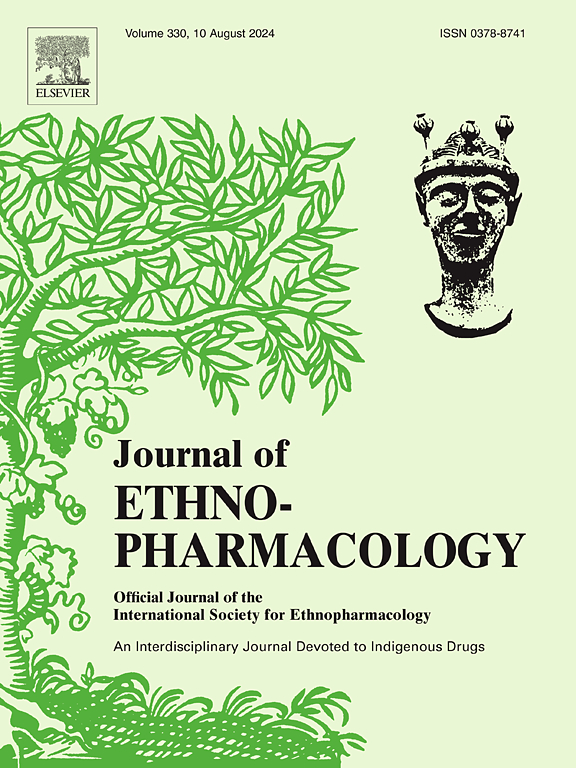Deciphering the effective components of a TCM formula for atherosclerosis by three-dimensional pattern recognition of exogenous components correlated with endogenous metabolites
IF 4.8
2区 医学
Q1 CHEMISTRY, MEDICINAL
引用次数: 0
Abstract
Ethnopharmacological relevance
The deciphering of effective components is crucial for understanding the role they play and how they function in traditional Chinese medicine (TCM) formulae. However, this remains a significant challenge for these complex systems with multiple components, targets, and pathways, despite their therapeutic benefits.
Aim of the study
Three-dimensional pattern recognition of exogenous components correlated with endogenous metabolites was proposed to discover the effective components of Gualou-Xiebai-Banxia decoction (GXB), a famous classical TCM formula for effective improvement of atherosclerosis (AS).
Materials and methods
The potential effective exogenous components were determined by three-dimensional pattern recognition of abundance, bioavailability and AS-related activity. The efficacy of GXB in attenuating AS was evaluated using an Apolipoprotein E-deficient (ApoE−/−) mice model subjected to a high-fat diet regimen. Plasma metabolomics was developed to dig out GXB efficacy-related endogenous metabolites. Next, the potential effective exogenous components and GXB efficacy-related endogenous metabolites were combined with AS targets to develop correlation analysis, so as to explore candidate effective components and potential mechanisms of GXB. Further, the effective components were validated by oxidized low-density lipoprotein-induced RAW 264.7 macrophages.
Results
A total of 30 potential effective exogenous components in GXB were ascertained by three-dimensional pattern recognition after conducting Technique for Order of Preference by Similarity to Ideal Solution (TOPSIS) analysis. GXB demonstrated a significant ameliorative effect on atherosclerotic symptoms in ApoE−/− mice under a high-fat diet, as evidenced by decreasing serum lipid levels, atherosclerotic plaques (aorta and aortic root) and IL-6 content. Subsequently, metabolomics results revealed that it was associated with the regulation of endogenous metabolites, including organic acids, amino acid, fatty acids and glycerophospholipid. Next, the correlation analysis was constructed with AS targets by the network of “potential effective exogenous components-AS targets-endogenous metabolites”, tentatively inferring that 18 exogenous components were candidate effective components, and lipid metabolism was the major regulation pathway of GXB. Furthermore, GXB suppressed lipid accumulation in vivo/vitro through increasing expressions of PPAGγ, ABCA1, ABCG1, and SR-B1 related to cholesterol efflux. Cucurbitacin B and 5 (6)-ene-macrostemonoside B were demonstrated as the effective components with inhibitory activity on foam cell formation and lipid accumulation.
Conclusion
Three-dimensional pattern recognition of exogenous components correlated with endogenous metabolites was proposed and effectively utilized to demystify the effective components of GXB in AS prevention. This strategy also provided a reference for the related studies of other classical TCM formulae.

求助全文
约1分钟内获得全文
求助全文
来源期刊

Journal of ethnopharmacology
医学-全科医学与补充医学
CiteScore
10.30
自引率
5.60%
发文量
967
审稿时长
77 days
期刊介绍:
The Journal of Ethnopharmacology is dedicated to the exchange of information and understandings about people''s use of plants, fungi, animals, microorganisms and minerals and their biological and pharmacological effects based on the principles established through international conventions. Early people confronted with illness and disease, discovered a wealth of useful therapeutic agents in the plant and animal kingdoms. The empirical knowledge of these medicinal substances and their toxic potential was passed on by oral tradition and sometimes recorded in herbals and other texts on materia medica. Many valuable drugs of today (e.g., atropine, ephedrine, tubocurarine, digoxin, reserpine) came into use through the study of indigenous remedies. Chemists continue to use plant-derived drugs (e.g., morphine, taxol, physostigmine, quinidine, emetine) as prototypes in their attempts to develop more effective and less toxic medicinals.
 求助内容:
求助内容: 应助结果提醒方式:
应助结果提醒方式:


